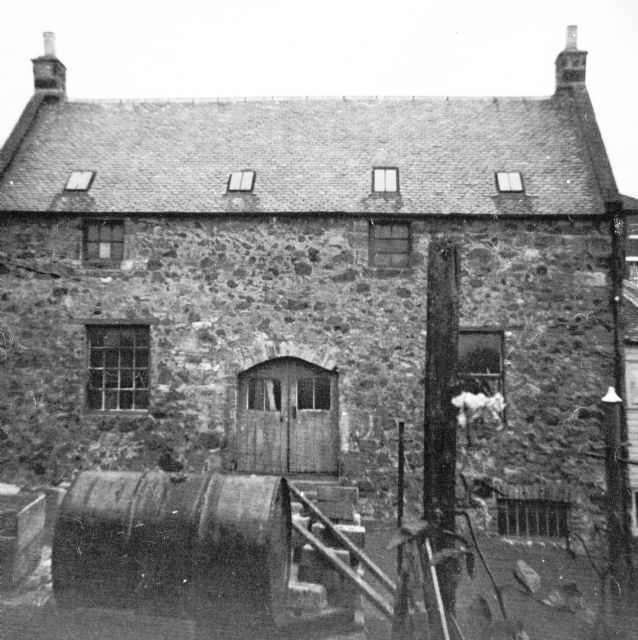The Old Grain Mills of Kinghorn
There are records confirming there were two grain mills of ancient origin on the Loch Burn in Kinghorn:
· The Overmill in Glamis Road.
· The Nether Mill located in the South Overgate.
The Overmill (Overmiln)
The Glamis Tower belonged to the Royal family from earliest times. In 1463 Mary of Guise granted a charter to Alexander Lyon the second earl of Glamis giving him possession of the Castle of Kinghorn with the mill and mill lands for him and his heirs.
In 1548 James Dog of Dunrobin received a charter from Mary Queen of Scots: ‘ac superius molendinum de Kingorne et 8 acras terrarum nuncupate’. [The Overmill of Kinghorn with 8 acres of land]. John Kirkcaldie received a charter to the mill in 1616: ‘superior molendinum (lie Overmylne) burgi de Kinghorne, cum 6 acris arabilibus ad idem pertinentibus ...and right to the loch water’. A charter dated 1649 records the mill had passed on to Robert Beatson of Kilrie together with the lands of Nether Piteadie and Balbairdie. It was then passed on through several generations of Robert Beatsons until 1783.
However, according to the Kinghorn Town Council minutes for 11th May 1772 the Council believed they had purchased the Overmill from a Robert Beatson in 1703 together with the accompanying thirlage (land) and multures (percentage of the grain ground at the mill). No record of this purchase could be found although the Council instigated a search. The Council had leased out the mill and repaired the mill since 1703 with no input from the various Robert Beatsons. In 1776 representatives of the Council were summoned before the Court of Session to settle the dispute over the ownership of the Overmill. No resolution was found and in 1790 the argument flared again with another Robert Beatson telling the Council to take out an action against him. The matter must have been settled eventually because the Town Council were able to sell the Overmill in 1880.
The Nether Mill
The Nether Mill in the South Overgate is mentioned in a charter granted by James VI in 1611. Charters had been lost in times of war and fire in the town, so this charter was necessary to confirm Kinghorn’s right as a Royal Burgh and to confirm its rights to land conferred upon it. Of the mill the charter states: ‘together with the mill lying in the said burgh called the lower mill, mill lands multures and suckin thereof, with the loch of Kinghorne and water gang thereof from the said loch to the said nether mill of Kinghorne.’ This mill had probably belonged to the Burgh of Kinghorn for several centuries before.
Adminstration of both mills from 1703
From 1703 the Burgh of Kinghorn administered the two mills together. Periodically a lease would be put up for ‘roup’ (auction) with the lease of the two mills going to the highest bidder. The roup was announced to the community through ‘The Drum’, where a drummer would go around the town drumming and announcing the coming roup. The person who became the tacksman (leaseholder) of the mills was at liberty to sublet.
Both mills required constant maintenance. In 1751 the Nether Mill was in such poor shape a committee was appointed to inspect. The committee reported that: ‘the back wall, back [Shill] and staples are intensely rotten and it is there (sic) opinion the repair should be as in the hole (sic) miln .
The council decided to rebuild the mill. It cost £41 3s 5d and took just 3 months. Two years later the council spent £40 to repair the Overmill.
In the 1760s there was a proposal to build a brewery in Kinghorn. In order to grind the malted grain, steel mills were installed in both mills at different times. Both mills were able to grind grain in the ordinary way at the same time as using the steel mills.
For a few decades from 1790 the Overmill was used as a spinning mill, but latterly it was converted to a heckling house. In 1881 James Oswald purchased the mill for use as a joiner’s shop. Forty years later it was acquired by James Hay senior and continued as a joiner’s shop until it was converted into a house at the start of the 21st century.
From 1790 the Nether Mill had to be kept as a grain mill for use by the inhabitants of Kinghorn. By 1855 it had ceased to be used as a mill when a newer mill took on the grinding of grain. In 1876, Swan Brothers took out a lease on the Nether Mill for 25 years at an annual rent of £80 in order to ensure their right to the water from the Loch Burn and regulation of the sluice at the Loch. The agreement in the lease stated they should: ‘roof in the said Mill and other buildings and to board up the doors and windows thereof so as to prevent the public gaining access.’ This suggests the Nether Mill was by this time derelict. The remains of it were demolished in the 1960s and a row of modern houses now occupy the site.
Ginny Reid
The Overmill Glamis Road

